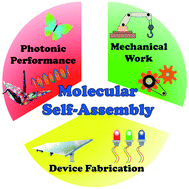当前位置:
X-MOL 学术
›
Mol. Syst. Des. Eng.
›
论文详情
Our official English website, www.x-mol.net, welcomes your
feedback! (Note: you will need to create a separate account there.)
Bottom-up approaches for material and device designing using practical aspects of self-assembled molecular architectures
Molecular Systems Design & Engineering ( IF 3.2 ) Pub Date : 2018-08-23 00:00:00 , DOI: 10.1039/c8me00020d Toshihiro Ohtake 1, 2, 3
Molecular Systems Design & Engineering ( IF 3.2 ) Pub Date : 2018-08-23 00:00:00 , DOI: 10.1039/c8me00020d Toshihiro Ohtake 1, 2, 3
Affiliation

|
Self-assembly is an ordered form of spontaneous molecular organization via specific inter- or intramolecular interactions. Self-assembled molecular architectures are ubiquitous in biological systems and exhibit specific functions. These unique characteristics are of significant interest for technological platforms in material and device design. More recently, this technology has made considerable progress in furthering the fields of biosensors, optoelectronic devices, and actuators. This review focuses on the practical aspects of dynamic properties in self-assembled molecular architectures such as motion, shape change, photonic efficiency, and mass transport, discusses the current challenges in the field, and suggests future scope and direction in bottom-up design of materials and devices by demonstration of specific cases.
中文翻译:

使用自组装分子架构的实际方面进行材料和设备设计的自下而上的方法
自组装是通过特定的分子间或分子内相互作用。自组装分子结构在生物系统中无处不在,并表现出特定的功能。这些独特的特性对于材料和设备设计中的技术平台具有重大意义。最近,这项技术在扩展生物传感器,光电器件和致动器领域取得了长足的进步。这篇综述着重于自组装分子结构中动力学特性的实际方面,例如运动,形状变化,光子效率和质量传输,讨论了该领域当前的挑战,并提出了自下而上设计的未来范围和方向。通过具体案例的演示来展示材料和设备。
更新日期:2018-08-23
中文翻译:

使用自组装分子架构的实际方面进行材料和设备设计的自下而上的方法
自组装是通过特定的分子间或分子内相互作用。自组装分子结构在生物系统中无处不在,并表现出特定的功能。这些独特的特性对于材料和设备设计中的技术平台具有重大意义。最近,这项技术在扩展生物传感器,光电器件和致动器领域取得了长足的进步。这篇综述着重于自组装分子结构中动力学特性的实际方面,例如运动,形状变化,光子效率和质量传输,讨论了该领域当前的挑战,并提出了自下而上设计的未来范围和方向。通过具体案例的演示来展示材料和设备。











































 京公网安备 11010802027423号
京公网安备 11010802027423号